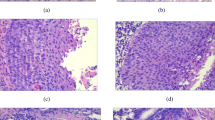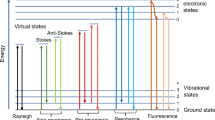Abstract
Cervical cancer is the fourth most common cancer in women worldwide and mainly affects younger women. The mortality associated with cervical cancer can be reduced if the disease is detected at the pre-cancer stage. Current best-practice methods include cytopathology, HPV testing, and histopathology, but these methods are limited in terms of subjectivity, cost, and time. There is an unmet clinical need for new methods to aid clinicians in the early detection of cervical pre-cancer. These methods should be objective and rapid and require minimal sample preparation. Raman spectroscopy is a vibrational spectroscopic technique by which incident radiation is used to induce vibrations in the molecules of a sample and the scattered radiation may be used to characterise the sample in a rapid and non-destructive manner. Raman spectroscopy is sensitive to subtle biochemical changes occurring at the molecular level, enabling spectral variations corresponding to disease onset to be detected. Over the past 15 years, there have been numerous reports revealing the potential of Raman spectroscopy together with multivariate statistical analysis for the detection of a variety of cancers. This paper discusses the recent advances and challenges for cervical-cancer screening and diagnosis and offers some perspectives for the future.





Similar content being viewed by others
References
Ferlay J, Soerjomataram I, Ervik M, Dikshit R, Eser S, Mathers C, Rebelo M, Parkin DM, Forman D, Bray F (2012) GLOBOCAN, v1.0, Cancer incidence and mortality worldwide: IARC Cancer Base No. 11, 2013. International Agency for Research on Cancer
Walboomers JM, Jacobs MV, Manos MM, Bosch FX, Kummer JA, Shah KV, Snijders PJ, Peto J, Meijer CJ, Munoz N (1999) Human papillomavirus is a necessary cause of invasive cervical cancer worldwide. J Pathol 189:12–19
Franco EL, Schlecht NF, Saslow D (2003) The epidemiology of cervical cancer. Cancer J 9:348–359
Koss LG, Melamed MR (2006) Koss’ diagnostic cytology and its histopathologic bases, 5th edn. Lippincott Williams & Wilkins, Philadelphia
Kurman RJ, Solomon D (1994) The Bethesda system for reporting cervical/vaginal cytologic diagnoses: definitions, criteria and explanatory notes for terminology and specimen adequacy. Springer Verlag, New York
Herbert A, Bergeron C, Wiener H, Schenck U, Klinkhamer P, Bulten J et al (2007) European guidelines for quality assurance in cervical cancer screening: recommendations for cervical cytology terminology. Cytopathology 18:213–219
Kitchener HC, Blanks R, Cubie H, Desai M, Dunn G, Legood R, Gray A, Sadique Z, Moss S, MAVARIC Trial Study Group (2011) MAVARIC—A comparison of automation-assisted and manual cervical screening: a randomised controlled trial. Health Technol Assess 15:1–170
Schiffman M, Wentzensen N, Wacholder S, Kinney W, Gage JC, Castle PE (2011) Human papillomavirus testing in the prevention of cervical cancer. J Natl Cancer Inst 103:368–383
Ronco G, Giorgi-Rossi P, Carozzi F, Confortini M, Dalla Palma P, Del Mistro A et al (2010) Efficacy of human papillomavirus testing for the detection of invasive cervical cancers and cervical intraepithelial neoplasia: a randomised controlled trial. Lancet Oncol 11:249–257
Cuzick J, Cadman L, Mesher D, Austin J, Ashdown-Barr L, Ho L et al (2013) Comparing the performance of six human papillomavirus tests in a screening population. Br J Cancer 108:908–913
Castle PE, de Sanjosé S, Qiao YL, Belinson JL, Lazcano-Ponce E, Kinney W (2012) Introduction of human papillomavirus DNA screening in the world: 15 years of experience. Vaccine 20(30 Suppl 5):F117–F122
Dalla Palma P, Giorgi Rossi P, Collina G, Buccoliero AM, Ghiringhello B, Lestani M et al (2008) The risk of false-positive histology according to the reason for colposcopy referral in cervical cancer screening: a blind revision of all histologic lesions found in the NTCC trial. Am J Clin Pathol 129:75–80
Stoler MH, Schiffman M (2001) Interobserver reproducibility of cervical cytologic and histologic interpretations: realistic estimates from the ASCUS-LSIL Triage Study. JAMA 285:1500–1505
Parker MF, Zahn CM, Vogel KM, Olsen CH, Miyazawa K, O'Connor DM (2002) Discrepancy in the interpretation of cervical histology by gynecologic pathologists. Obstet Gynecol 100:277–280
Grenko RT, Abendroth CS, Frauenhoffer EE, Ruggiero FM, Zaino RJ (2000) Variance in the interpretation of cervical biopsy specimens obtained for atypical squamous cells of undetermined significance. Am J Clin Pathol 114:735–740
Diem M (1993) Introduction to modern vibrational spectroscopy. Wiley, New York
Diem M, Mazur A, Lenau K, Schubert J, Bird B, Miljkovic M, Krafft C, Popp J (2013) Molecular pathology via IR and Raman spectral imaging. J Biophotonics 6:855–886
Ellis DI, Cowcher DP, Ashton L, O'Hagan S, Goodacre R (2013) Illuminating disease and enlightening biomedicine: Raman spectroscopy as a diagnostic tool. Analyst 138:3871–3884
Kendall C, Isabelle M, Bazant-Hegemark F, Hutchings J, Orr L, Babrah J, Baker R, Stone N (2009) Vibrational spectroscopy: a clinical tool for cancer diagnostics. Analyst 134:1029–1045
Nijssen A, Koljenovic S, Bakker Schut TC, Caspers PJ, Puppels GJ (2009) Towards oncological application of Raman spectroscopy. J Biophotonics 2:29–36
Movasaghi Z, Rehman S, Rehman IU (2007) Raman spectroscopy of biological tissues. Appl Spectrosc Rev 42:493–541
Rashid N (2013) Raman microspectroscopy for the characterization of cervical cancer, PhD thesis, Dublin Institute of Technology
Fullwood LM, Griffiths D, Ashton K, Dawson T, Lea RW, Davis C, Bonnier F, Byrne HJ, Baker MJ (2014) Effect of substrate choice and tissue type on tissue preparation for spectral histopathology by Raman microspectroscopy. Analyst 139:446–454
Kerr LT, Byrne HJ, Hennelly BM (2015) Optimal choice of sample substrate and laser wavelength for Raman spectroscopic analysis of biological specimens. Anal Methods (accepted)
Fung Kee Fung M, Senterman M, Eid P, Faught W, Mikhael NZ, Wong PT (1997) Comparison of Fourier-transform infrared spectroscopic screening of exfoliated cervical cells with standard Papanicolaou screening. Gynecol Oncol 66:10–15
Neviliappan S, Fang Kan L, Tiang Lee Walter T, Arulkumaran S, Wong PTT (2002) Infrared spectral features of exfoliated cervical cells, cervical adenocarcinoma tissue, and an adenocarcinoma cell line (SiSo). Gynecol Oncol 85:170–174
Wong PT, Wong RK, Caputo TA, Godwin TA, Rigas B (1991) Infrared spectroscopy of exfoliated human cervical cells: evidence of extensive structural changes during carcinogenesis. Proc Natl Acad Sci U S A 1991(88):10988–10992
Wong PTT, Senterman MK, Jackli P, Wong RK, Salib S, Campbell CE, Feigel R, Faught W, Fung Kee Fung M (2002) Detailed account of confounding factors in interpretation of FTIR spectra of exfoliated cervical cells. Biopolymers 67:376–386
Chiriboga L, Xie P, Vigorita V, Zarou D, Zakim D, Diem M (1998) Infrared spectroscopy of human tissue. II. A comparative study of spectra of biopsies of cervical squamous epithelium and of exfoliated cervical cells. Biospectroscopy 4:55–59
Cohenford MA, Godwin TA, Cahn F, Bhandare P, Caputo TA, Rigas B (1997) Infrared spectroscopy of normal and abnormal cervical smears: evaluation by principal component analysis. Gynecol Oncol 66:59–65
Diem M, Chiriboga L, Lasch P, Pacifico A (2002) IR spectra and IR spectral maps of individual normal and cancerous cells. Biopolymers 67:349–353
Romeo MJ, Quinn MA, Burden FR, McNaughton D (2002) Influence of benign cellular changes in diagnosis of cervical cancer using IR microspectroscopy. Biopolymers 67:362–366
Wood BR, Quinn MA, Tait B, Ashdown M, Hislop T, Romeo M, McNaughton D (1998) FTIR microspectroscopic study of cell types and potential confounding variables in screening for cervical malignancies. Biospectroscopy 4:75–91
Rubina S, Amita M, Kedar KD, Bharat R, Krishna CM (2013) Raman spectroscopic study on classification of cervical cell specimens. Vib Spectrosc 68:115–121
Bonnier F, Traynor D, Kearney P, Clarke C, Knief P, Martin C, O’Leary JJ, Byrne HJ, Lyng F (2014) Processing ThinPrep cervical cytological samples for Raman spectroscopic analysis. Anal Methods 6:7831–7841
Jess PRT, Simth DDW, Mazilu M, Dholakia K, Riches AC, Herrington CS (2007) Early detection of cervical neoplasia by Raman spectroscopy. Int J Cancer 121:2723–2728
Ostroswka KM, Malkin A, Meade A, O’Leary J, Martin C, Spillane C, Byrne HJ, Lyng FM (2010) Investigation of the influence of high-risk human papillomavirus on the biochemical composition of cervical cancer cells using vibrational spectroscopy. Analyst 135:3087–3093
Vargis E, Tang Y-W, Khabele D, Mahadevan-Jansen A (2012) Near-infrared Raman microspectroscopy detects high-risk human papillomaviruses. Transl Oncol 5:172–179
Krishna CM, Sockalingum GD, Vadhiraja BM, Maheedhar K, Rao ACK, Rao L, Venteo L, Plutot M, Fernandes DJ, Vidyasagar MS, Kartha BVB, Manfait M (2006) Vibrational spectroscopy studies of formalin-fixed cervix tissues. Biopolymers 85:214–221
Lyng FM, Faolain EO, Conroy J, Meade AD, Knief P, Duffy B, Hunter MB, Byrne JM, Kelehan P, Byrne HJ (2007) Vibrational spectroscopy for cervical cancer pathology, from biochemical analysis to diagnostic tool. Exp Mol Pathol 82:121–129
Kamemoto LE, MisRa AK, Sharma SK, Goodman MT, Luk H, Dykes AC, Acosta T (2010) Near-infrared micro-Raman spectroscopy for in vitro detection of cervical cancer. Appl Spectrosc 64:255–261
Tan KM, Herrington CS, Brown CT (2011) Discrimination of normal from pre-malignant cervical tissue by Raman mapping of de-paraffinized histological tissue sections. J Biophotonics 4:40–48
Rashid N, Nawaz H, Poon KW, Bonnier F, Bakhiet S, Martin C, O'Leary JJ, Byrne HJ, Lyng FM (2014) Raman microspectroscopy for the early detection of pre-malignant changes in cervical tissue. Exp Mol Pathol 97:554–564
Mahadevan-Jasen A, Mitchel MF, Ramanujam N, Utzinger U, Richards-Kortum R (1998) Development of a fiber optic probe to measure NIR Raman spectra of cervical tissue in vivo. Photochem Photobiol 68:427–431
Utzinger U, Heintzelman DL, Mahadevan-Jasen A, Malpica A, Folen M, Richards-Kortum R (2001) Near-infrared Raman spectroscopy for in vivo detection of cervical precancers. Appl Spectrosc 55:959–995
Kanter EM, Majumder S, Kanter GJ, Woeste E, Mahadevan-Jasen A (2009) Effect of hormonal variation on Raman spectra for cervical disease detection. Am J Obstet Gynecol 200:512, e1–5
Vargis E, Kanter EM, Majumder S, Keller MD, Beaven RB, Rao GG, Mahadevan-Jasen A (2011) Effect of normal variations on disease classification of Raman spectra from cervical tissue. Analyst 136:2981–2987
Vargis E, Byrd T, Logan Q, Khabele D, Mahadevan-Jansen A (2011) Sensitivity of Raman spectroscopy to normal patient variability. J Biomed Opt 16:117004
Mo J, Zheng W, Low JJH, Ng J, Ilancheran A, Huang Z (2009) High wavenumber Raman spectroscopy for in vivo detection of cervical dysplasia. Anal Chem 81:8908–8915
Duraipandian S, Zheng W, Ng J, Low JJH, Ilancheran A (2012) Simultaneous fingerprint and high-wavenumber confocal Raman spectroscopy enhances early detection of cervical precancer in vivo. Anal Chem 84:5913–5919
Byrne HJ, Baranska M, Puppels GJ, Stone N, Wood B, Gough KM, Lasch P, Heraud P, Sulé-Suso J, Sockalingum GD (2015) Spectropathology for the next generation: Quo Vadis? Analyst 140:2066–2073
Bassan P, Sachdeva A, Shanks J, Brown MD, Clarke NW, Gardner P (2013) Whole organ cross-section chemical imaging using label-free mega-mosaic FTIR microscopy. Analyst 138:7066–7069
Tfayli A, Gobinet C, Vrabie V, Huez R, Manfait M, Piot O (2009) Digital dewaxing of Raman signals: discrimination between nevi and melanoma spectra obtained from paraffin-embedded skin biopsies. Appl Spectrosc 63:564–570
Acknowledgments
The authors acknowledge funding from Enterprise Ireland co-funded by the European Regional Development Fund (ERDF) and Ireland’s EU Structural Funds Programme 2007–2013, CF2011 1045, the Health Research Board Collaborative Applied Research Grant, CARG2012/29, and Dublin Institute of Technology Fiosraigh Research Excellence Award.
Author information
Authors and Affiliations
Corresponding author
Additional information
Published in the topical collection Raman4Clinics with guest editors Jürgen Popp and Christoph Krafft.
Rights and permissions
About this article
Cite this article
Lyng, F.M., Traynor, D., Ramos, I.R.M. et al. Raman spectroscopy for screening and diagnosis of cervical cancer. Anal Bioanal Chem 407, 8279–8289 (2015). https://doi.org/10.1007/s00216-015-8946-1
Received:
Revised:
Accepted:
Published:
Issue Date:
DOI: https://doi.org/10.1007/s00216-015-8946-1




